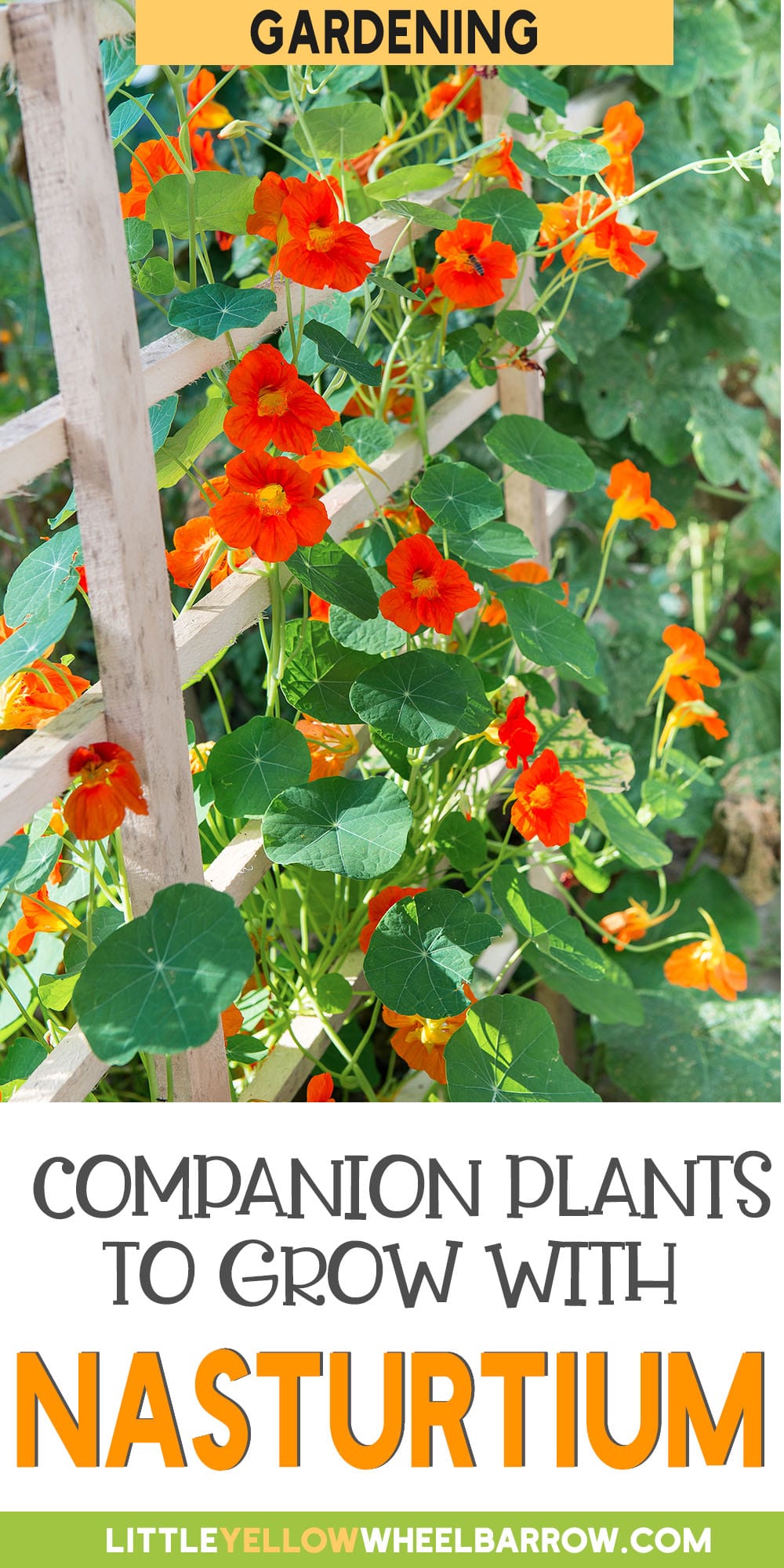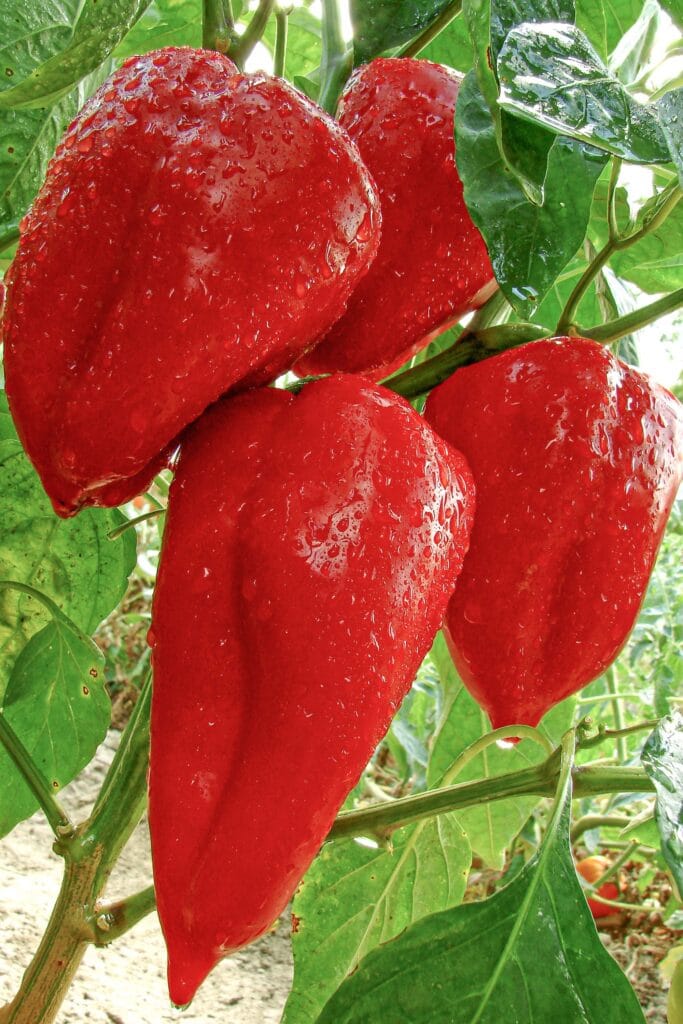The Best Nasturtium Companion Plants For Your Gardens
Nasturtium companion plants offer a vibrant and versatile gardening strategy to enhance your garden’s health, beauty, and productivity. If you are looking to diversify your garden ecosystem or are eager to explore the benefits of companion planting, this article is designed to provide you with valuable insights and practical advice to help you along.

Integrating nasturtiums alongside compatible plants can naturally deter pests, improve soil health, and create a more dynamic and visually appealing garden space. Join us as we explore why you want to grow nasturtium companion plants in your garden spaces.
Plants that Like Being Neighbors With Nasturtium
Here is a quick list of the plants that do well interplanted with nasturtiums. In the remaining article, we go through each plant to explain why each one is a good pairing and the benefits. Vegetable plants, in particular, benefit significantly from interplanting with nasturtiums.

Apples
Apple trees and nasturtiums may not seem likely to pair, but underplanting apple trees with nasturtiums can help deter coddling moths from infesting the trees. It acts as a sacrificial plant to lure the coddling moth away from the fruit.
Although nasturtiums like full sun, they will grow under the shade of an apple tree; they may not bloom as profusely. Nasturtium leaves have the same repelling effect as the nasturtium flowers.

The Brassica Family
Members of the brassica family grow stronger with nasturtium interplanted. In addition, the flowers keep Japanese beetles, aphids, cabbage worms, and cabbage loopers away from the crops.
Broccoli, Brussels sprouts, cabbage, cauliflower, kale, and kohlrabi are companion possibilities.
With that said, if you have high pest pressure in your gardens, there could be a risk here as the nasturtiums may not trap all pests. With heavy pest pressure, you could attract the pests directly to your cauliflower or broccoli plants, for example.
Carrots
Nasturtiums are a great companion plant for carrots because they repel carrot root flies, aphids, cucumber beetles, and other pests. They make an excellent trap crop for carrots.
The plants also provide carrots with a living mulch, which helps to keep the ground moist.
- Learn More: Did you know you can grow carrots in containers? You can! We have the full guide to help you get started.
Potatoes
In the potato garden beds, nasturtiums help repel the Colorado potato beetle. They act as attractive sacrificial plants, luring predatory pests, such as aphids and potato beetles away from the potato crops.
Plant Nasturtium flowers alongside French marigolds in the potato beds to create a lovely potager-garden style display.
Lavender
Lavender and nasturtiums make an excellent pairing in the garden, offering functional and aesthetic benefits. Lavender’s strong scent is a natural pest repellent, deterring moths, fleas, and mosquitoes. At the same time, nasturtiums attract beneficial pollinators with their bright flowers. This combination enhances pollination and offers dual-layer pest control without relying on chemical pesticides. In addition, lavender’s antifungal properties help protect both plants from fungal diseases, which is especially beneficial in humid climates.
Both plants share similar cultural requirements, such as well-drained soil and low water needs. This promotes harmonious growth and a healthier environment.

Other Vegetables In The Garden
Plant nasturtium around tomatoes, celery, radishes, and spinach to deter whiteflies, tomato hornworms, and aphids from taking hold.
Note: For tomatoes specifically, plant the nasturtiums away from the stems of the tomato plants. Aphids will go for the nasturtiums before they go for the tomato plants, but if they have not been pruned or are touching the ground, the aphids will not think twice about hopping onto the tomato plant.

What Not To Plant Next To Nasturtiums
While nasturtiums are generally compatible with a wide range of plants, there are a few specific examples where pairing them might not be ideal, especially in terms of shared pests or differing cultural requirements. Here are some specifics:
Squash and Pumpkins
These plants are not necessarily bad companions for nasturtiums, but because nasturtiums can attract squash bugs as part of their trap crop role, there’s a risk if not managed correctly. If the nasturtiums are overwhelmed or the pests are uncontrolled, they could move onto the squash and pumpkins.
Runner Beans
Some anecdotal advice suggests that beans and nasturtiums may not grow well together, potentially due to differing soil nutrient requirements. Nasturtiums prefer poorer soils and can thrive with less water and fertility, while beans prefer richer soil. This mismatch can lead to suboptimal growth for one or both plants.
It’s important to note that bad companions can vary based on specific garden conditions, pest pressures, and the gardener’s management practices. For example, if you actively manage pests and ensure balanced soil nutrition, you might not experience any negative interactions between nasturtiums and the abovementioned plants.

Expert Tips
Here are the top things to remember when using nasturtiums in the vegetable garden:
- Pest Management: Nasturtiums are a natural repellent for aphids, squash bugs, and beetles, protecting nearby vegetables and fruits. Their strong scent deters pests, making them an excellent choice for organic gardens.
- Soil Improvement: Their deep roots pull nutrients from the soil, benefiting shallower-rooted plants. As they grow, nasturtiums also provide living mulch, which helps to preserve soil moisture and suppress weeds.
- Trap Crops: Plant nasturtiums near tomatoes, cucumbers, kale, cabbage, radishes, and fruit trees to lure pests away and ensure healthier crops.
- Attracting Beneficial Insects: The bright flowers attract bees, butterflies, and predatory insects such as ladybugs, which help control pest populations.
- Edible Landscaping: Nasturtiums have edible flowers, leaves, and seeds. Nasturtium leaves, flowers, and seeds add a peppery flavor to dishes, offering aesthetic and culinary benefits to your garden.
- Strategic Planting: Use nasturtiums to border vegetable beds or intersperse them among crops for pest control. Choose dwarf varieties for small spaces and trailing and climbing nasturtium types for larger areas, ensuring they don’t overshadow smaller plants.
Incorporating nasturtiums into your garden enhances its beauty and diversity and promotes a healthier, more sustainable gardening ecosystem.
FAQ
Our favorite type of nasturtium is the whirlybird series with semi-double flowers atop bushy plants that have a spectacular display of color. The flowers come in cherry, gold, mahogany, orange, peach, and scarlet. Gorgeous as a border bedding plant. These plants will bloom prolifically all summer long.
You will want to avoid planting nasturtiums near pole beans, and plants like squash and pumpkin, where pairing them might not be ideal, especially regarding shared pests or differing growing requirements.
Grab Our Ultimate PRINTABLE Garden Planner
With 39 pages of planning and organizing and the ability to customize your planner with the pages you need, you won’t need another planner for the rest of your gardening life!
$4.99 US

Final Remarks
As you can see, many different varieties of plants pair exceptionally well with nasturtiums. These lovely bushy plants with vibrant flowers and lazy trailing vines make an excellent visual addition to any garden while providing organic gardeners with a non-chemical way to deal with pests.
If you plant Nasturtiums in your gardens this summer, tag us on social media with your pictures. We love seeing gardens in blooms and how our readers creatively design their vegetable gardens every summer.
Cheers to a bountiful gardening season!
Related Posts

Author: Laura Kennedy
Writer & Owner of Little Yellow Wheelbarrow
Editor’s Note: This post first appeared on January 26, 2022, and was updated on February 11, 2024. The update includes better headers and formatting and the inclusion of a Table of Contents, Expert Tips, and FAQ.











